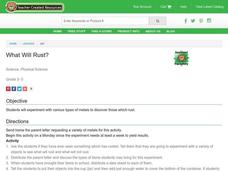Curated OER
Make Your Own Thermometer
Students recognize the concept of temperature, including degrees, and the melting and freezing process. In this 1st - 2nd grade lesson plan, students identify the temperature of various objects, as well as create their own paper...
Curated OER
Quiz Questions - Cells
In this cells worksheet, students read and choose the multiple choice answers to 20 questions involving cells, microscopes, and the life process of Growth.
Curated OER
Ladybug Life Cycle
In these life cycle worksheets, students color the ladybug life cycle pictures and then cut them out. Students then glue them to the life cycle chart to show the correct order of a ladybug's life cycle. Students write the name of each...
Curated OER
States of Matter
In this states of matter worksheet, students read a 2 page article on the 5 states of matter, answer statements with multiple choice answers, fill in 4 fill in the blank statements and 3 true or false statements about the 5 states of...
Curated OER
How Food Moves Through the Body
In this food and digestion worksheet, students read a short article the digestive system and choose the multiple choice answer for 11 questions. Students also put the organs that food moves through in the correct sequential order.
Curated OER
What Are Solutions?
In this solutions worksheet, students brainstorm different types of solutions and an example of each type of solution. This worksheet is a graphic organizer.
Curated OER
What Are Physical and Chemical Properties?
In this properties worksheet, students compare and contrast physical properties and chemical properties. This worksheet is a graphic organizer.
Curated OER
Starch is Everywhere
In this science instructional activity, students add a few drops of iodine solution to each of 10 substances to determine if they contain starch. The iodine will turn blue if the item contains starch.
Curated OER
Insect Anatomy
In this insect anatomy worksheet, students utilize a word bank to label the six parts of an insect: abdomen, antennae, head, legs, thorax and wings.
Curated OER
Cells
In this cells worksheet, students review and discuss eighteen key terms associated with cells and circle each one in a word search puzzle.
Curated OER
Blood
In this blood worksheet, students review and discuss eighteen key terms associated with blood and circle each one in a word search puzzle.
Curated OER
Experiment: Refraction And The Reappearing Coin
In this refraction worksheet, students perform an experiment by putting a penny in a bowl, walking off and turning back around to see if they can still see the penny or not.
Curated OER
The Moon
In this moon instructional activity, students write facts they know about the moon and what they would like to know. Students color and fold this instructional activity into a little book.
Curated OER
Chemistry: Mini-Volcanoes
Young scholars observe an experiment using common household chemicals to simulate a volcanic eruption. In small cups, they follow the teacher's instructions to make their own volcanoes. After watching a Brain-pop video, students complete...
Curated OER
Matter Matters
Students review the three states of matter and discuss if water can change from a solid to a liquid. They watch the BrainPOP Jr. video about the states of matter and discuss if they saw water change from a solid to a liquid and what made...
Environmental Protection Agency (EPA)
Learn About Chemicals Around Your House
Take a house tour and play some games to learn about household products that have chemicals and how to be safe around them. From the U.S. Environmental Protection Agency (EPA).
Curated OER
Water: Liquid or Solid?
First graders investigate how water can be both a liquid and a solid. They weigh popsicles and observe them as they write in their science journals. They measure the liquid as the popsicle melts and refreeze them to change them back...
Curated OER
What Will Rust?
Students discuss if they have ever seen anything that has rusted. They place metal objects into the cup and then add just enough water to cover the bottom of the container. They complete information on their data sheets and record as...
Curated OER
Slime and Polymers
Students participate in an experiment to demonstrate how mixing certain chemicals together can change the consistency of both chemicals. Glue, water, and borax are used to create a slime-like substance which is examined to determine how...
Curated OER
Sound is Vibration
Young scholars poll what sounds are caused by vibrations in things. They collect a variety of household items to test out their theories. A variety of experiments commence. Discussion of high and low tones occur.
Curated OER
Substances And Chemical Reactions
Students watch and predict chemical reactions when different substances are mixed together. They differentiate between solid, liquid, and gas.
Curated OER
Surface Tension (Soap Boat)
Students investigate the affect of soap and water temperature on surface tension.
Curated OER
What is pH and Why is it Important?
Students investigate acids, bases, and pH, and related this knowledge to the problem of acid deposition.

























